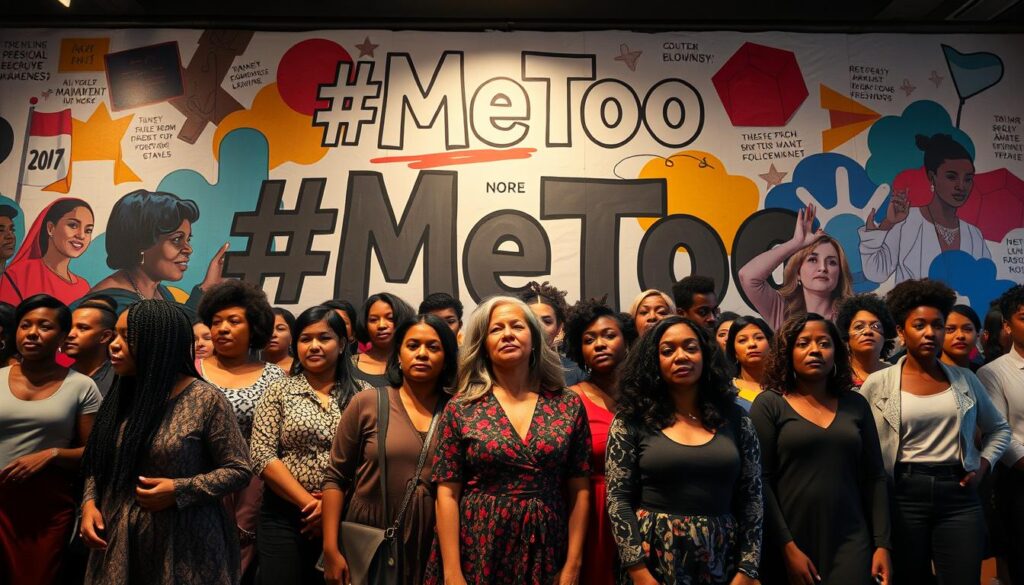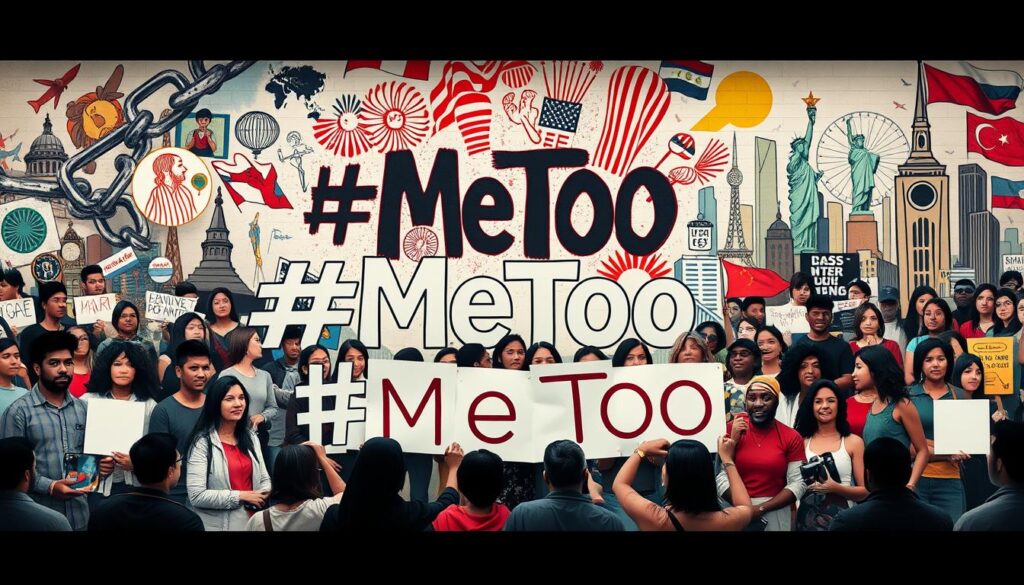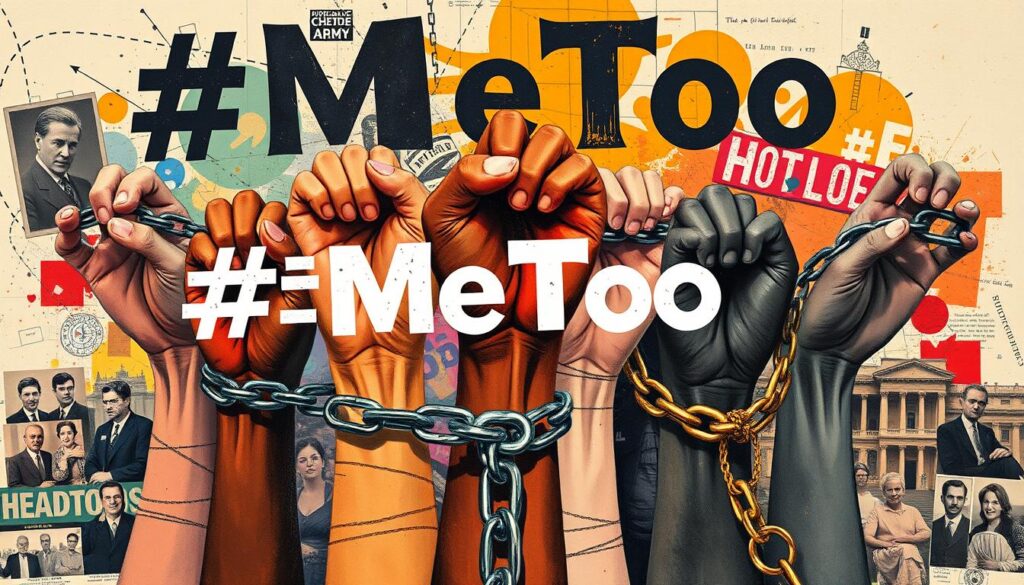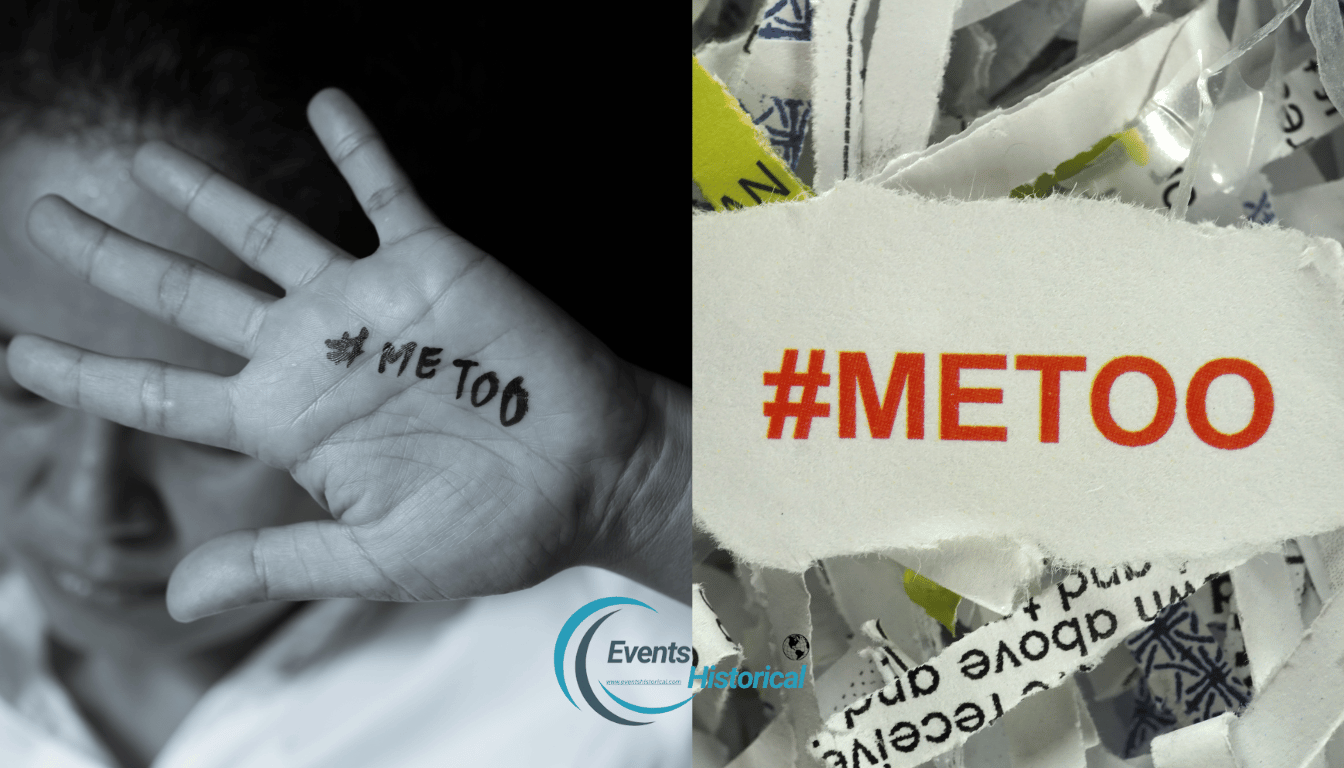Explore the MeToo Movement’s role in combating sexual harassment and promoting gender equality on a global scale. Join the change.
Ever thought a simple hashtag could start a worldwide fight against injustice? The #MeToo Movement has become a powerful force against sexual harassment and gender inequality. It brings together voices from all over, thanks to Tarana Burke’s vision. In 2017, it gained momentum, showing how common sexual violence is and the need for change worldwide.
More than one in three women have faced sexual harassment, making this movement crucial. It’s a call to action for women’s rights everywhere.
The MeToo Movement is changing attitudes and sparking important conversations. It’s pushing for changes in how we see and treat each other. Let’s look at what inspired this movement and how it’s changed our world.

Key Takeaways
- The #MeToo movement highlights the serious issue of sexual harassment affecting over one in three women globally.
- Approximately half of transgender individuals in the U.S. face sexual abuse or assault at some point in their lives.
- Social media played a crucial role in amplifying personal stories of sexual violence, leading to millions of tweets within six months of the movement’s inception.
- Black women highlighted the need for emotional support and raised awareness about discriminatory practices during the movement.
- The movement’s inception has prompted significant conversations and actions around workplace sexual harassment, especially in countries like India.
- Cultural norms in various societies, particularly in South Asia, pose significant barriers to discussing sexual violence openly.
The Origins of the #MeToo Movement
The #MeToo movement started in 2006, thanks to activist Tarana Burke. She wanted to help survivors of sexual violence, especially young women of color. Her goal was to create a safe space where people could share their stories without fear.
This grassroots effort paved the way for a bigger awareness campaign later on.
Founder’s Vision: Tarana Burke and Empowerment
Tarana Burke’s work on empowerment reached far and wide. She focused on helping marginalized voices be heard. Burke knew that sharing stories could help survivors feel less alone.
Her dedication to resilience helped spark the #MeToo movement’s growth.
The Viral Spread of #MeToo in 2017
In October 2017, the movement hit a turning point. Alyssa Milano’s tweet went viral, leading to millions of responses. This outpouring showed the widespread problem of sexual harassment.
It became a moment for people from all walks of life to share their stories and demand change.

The #MeToo movement shed light on sexual harassment in many fields. It challenged power imbalances and forced society to face the truth. This movement led to cultural and legislative changes, aiming to protect those who face discrimination and abuse.
| Year | Significant Events | Impact |
|---|---|---|
| 2006 | Tarana Burke coins “me too” | Foundation for empowerment within communities |
| 2017 | Alyssa Milano’s tweet | 12 million interactions in 24 hours; global awareness |
| 2018 | Legal reforms announced | Changes in laws around sexual harassment and retaliation |
| 2019 | Documentaries and films produced | Increased awareness of sexual violence in various sectors |
Understanding Sexual Harassment and Gender Inequality
Sexual harassment is a big problem that links closely with gender inequality in many areas. The sexual harassment definition includes unwanted sexual actions and words or physical acts. It’s important to know the different forms of harassment, like workplace harassment and sexual violence, which can happen in many ways.
Defining Sexual Harassment and Its Forms
Sexual harassment can happen in many ways, making it a complex issue. Common forms of harassment include:
- Unwanted touching or physical advances
- Inappropriate comments or jokes of a sexual nature
- Requesting sexual favors in exchange for job benefits
- Sexual coercion leading to physical violence
These actions not only make workplaces bad but also affect society’s issues with gender inequality and gender-based violence.
The Link Between Gender Inequality and Sexual Violence
It’s key to understand how sexual harassment ties into bigger problems. Gender inequality creates settings where harassment is more likely. Studies show that about 50% of women face sexual harassment at work.
This shows a deep problem in how jobs are set up. As more men are in a workplace, women face more harassment. But, when more women join jobs usually held by men, men might face more harassment too. These changes show how harassment can lead to more gender inequality.

MeToo Movement: The Global Fight Against Sexual Harassment and Gender Inequality
The MeToo movement has become a key global movement. It has inspired many to fight against sexual harassment and gender inequality. Starting with a simple phrase, it has launched a wide awareness campaign. This campaign crosses cultural and geographical lines, focusing on women’s rights.
MeToo activism shows the need for local efforts to combat sexual harassment. Communities worldwide have adopted the movement, adapting it to their unique challenges. They work together, from small meetings to big protests, to challenge harmful societal norms.
The core of the movement is to stop sexual harassment prevention. It has led to the creation of many resources, workshops, and training programs. These aim to educate people and organizations about harassment’s effects. They help create safe spaces for victims and hold organizations responsible.
| Aspect | Global Movement | Local Adaptations |
|---|---|---|
| Objective | Eradicate sexual violence | Address specific cultural issues |
| Awareness Campaigns | Global solidarity events | Community-focused initiatives |
| Educational Programs | Training for organizations | Workshops tailored to local contexts |
| Bystander Education | Encourage intervention strategies | Localized training methods |
Contributions from around the world add depth to the MeToo movement. They show the common struggles women face globally. The movement’s global network challenges norms and inspires courage. It’s crucial for achieving the movement’s goals, creating a safer, more equal society.
The Role of Social Media in the #MeToo Movement
Social media has changed the #MeToo movement a lot. It lets people share their stories and connect with others who have gone through similar things. Hashtags help spread the word, starting important talks about sexual harassment and pushing for change.
The Power of Hashtags in Inciting Change
The #MeToo hashtag became a big symbol for change. It was used over 19 million times on Twitter in just one year. This shows how the movement can get people talking and raise awareness.
It’s clear that many people have faced sexual harassment. In fact, 81% of women and 43% of men have. Social media is key in fighting against this.
Global Reach: Stories from Different Countries
The #MeToo movement is worldwide, showing many different experiences. Activists in China, India, and Brazil are all part of it. Their stories show how the movement can adapt and grow.
In China, activists use creative ways to get their message out, even with strict rules. Stories from all over help build a strong community of people wanting change.
Impact of the #MeToo Movement on Workplace Policies
The #MeToo movement has changed workplace policies a lot. It has led to big reforms in many areas. Now, companies in the US are working hard to stop sexual harassment.
Lawmakers have also stepped up. They have made new laws to help employees speak out against bad behavior safely.
Recent Legislation and Changes in Work Culture
New laws are key to better workplace cultures. Studies show that 79% of companies have seen big changes thanks to #MeToo. There was a 12% jump in EEOC charges from 2017 to 2018, showing the need for safer places.
Some big changes include:
- Three US states now limit non-disclosure agreements in sexual harassment cases.
- The French Labour Code requires a sexual harassment officer in big companies, with tough penalties.
- In Denmark, employers must deal with harassment quickly.
Many companies, 49%, want to change their culture about sexual harassment. Almost half of male managers feel uneasy in common work situations. This shows the need for a safer, more inclusive workplace.
Bystander Intervention: Building Supportive Work Environments
Bystander intervention is key to a supportive workplace. Programs that teach people to act when they see harassment help create a culture of responsibility. Companies that focus on bystander intervention see better results in stopping harassment.
When employees feel they can speak up, more harassment is reported. In fact, 35% of companies have seen more reports since #MeToo started.
Organizations can help by offering training. This teaches staff how to respond to harassment. Encouraging open talk helps prevent complacency and makes everyone aware of their role in keeping the workplace safe.
Challenges Faced by the MeToo Movement
The #MeToo movement has shed light on sexual harassment and gender inequality. Yet, it still faces many challenges. These hurdles make it hard for survivors and activists to move forward.
Backlash Against Survivors and Activists
Survivors who share their stories often face harsh backlash. They may be publicly shamed, threatened, or ostracized. This makes many hesitant to speak out.
More than 70% of workers who report abuse face retaliation. This shows the dangers of fighting for change.
Inadequate Support for Marginalized Communities
Marginalized groups face big barriers in the #MeToo movement. Many haven’t heard of it, especially Black and Hispanic people, women, and those with less education. The Time’s Up Legal Defense Fund has seen a lot of requests for help.
Most of these requests come from low-paid workers. This shows the need for more support for these groups. Without it, the movement can’t be truly inclusive.
| Statistical Insight | Details |
|---|---|
| Support for #MeToo | 49% of Americans express support five years after it went viral. |
| DemParty vs RepParty Support | Democrats are roughly three times more likely to support #MeToo than Republicans. |
| Awareness of #MeToo | 21% of adults overall have not heard of #MeToo, particularly among marginalized groups. |
| Commonality of Reporting | 46% say it’s extremely or very common to not report incidents of harassment or assault. |
| Retaliation After Reporting | More than 70% of individuals who report abuse face some form of retaliation. |
Survivor Support and Empowerment Initiatives
The #MeToo movement has highlighted the need for survivor support. Organizations are key in offering resources to those who have been sexually abused. They provide counseling, legal help, and community support to help survivors take back their lives.
These groups focus on empowering survivors. They aim to build resilience and help them heal.
Importance of Advocacy Groups and Resources
Advocacy groups stand up for survivors, making sure their voices are heard. Sadly, 736 million women worldwide have faced violence. Yet, only 5% of government aid goes to helping these women.
This shows how crucial survivor support is. Here’s a table showing the role of these organizations:
| Advocacy Group | Primary Focus | Key Resources Offered |
|---|---|---|
| RAINN | Sexual Assault Support | Hotline, Counseling, Legal Assistance |
| JustBe, Inc. | Empowerment for Young Women | Workshops, Educational Programs |
| Women Against Abuse | Domestic Violence Support | Shelter, Advocacy, Counseling |
Joining the Conversation: Empowering Underrepresented Voices
The movement is growing, bringing more voices to the table. Survivors from marginalized groups face extra challenges. It’s important to include their stories in the fight against gender inequality.
By sharing diverse experiences, advocacy groups aim to tackle sexual violence in a more complete way.
Global Perspectives: Cultural Differences in the #MeToo Movement
The #MeToo movement around the world is a rich mix of experiences. Each place has its own way of dealing with gender-based violence and sexual harassment. This shows how different cultures view these issues.
Looking at examples from different countries helps us see how the movement meets the needs of each place. It shows how it adapts to fit the local culture.
Case Studies from Different Countries
In Australia, the fight against sexual harassment is growing. Feminist groups are leading the charge. In South Africa, the focus is on stopping gender-based violence that hurts women a lot.
In the UK, there’s a push to change how men act. This is part of the #MeToo movement. These examples show how the movement looks different in each country.
Intersectionality: Addressing Diverse Needs Globally
Intersectionality is key in the #MeToo movement. It helps us see how different things like race, gender, and money status affect people. It’s about understanding how these things mix together.
Experts say it’s important to listen to everyone, especially those who are often ignored. For example, talking about queer and trans issues helps us see the bigger picture of gender-based violence. It shows we need to do more to protect everyone.
Future Directions for the #MeToo Movement
The #MeToo movement’s future depends on its ability to keep going beyond the initial buzz on social media. It needs new ways to keep people involved after the big attention in 2017 and 2018. We’ll look at how to keep the momentum going and build strong connections worldwide.
Sustaining Momentum Beyond Social Media
Social media has been great for getting the word out, but real change needs more. We need to talk to local communities and hold workshops to really understand sexual harassment. We should teach people about their rights, how to prevent it, and where to get help.
Building strong local movements helps people take action in their own places. This makes the #MeToo movement a lasting part of our culture.
- Workshops and Training: Regular workshops on preventing and handling sexual harassment.
- Public Awareness Campaigns: Campaigns to teach about laws on sexual harassment and gender equality.
- Support Hotlines: Confidential hotlines for survivors and to offer important resources.
Fostering International Collaboration for Change
The #MeToo movement can grow stronger with help from around the world. By working together, like in “The Global #MeToo Movement,” we can share ideas and success stories. This teamwork helps fight sexual violence and push for gender equality everywhere.
| Aspect | Description | Impact on #MeToo |
|---|---|---|
| Network Building | Creating alliances between local and global organizations | Increased reach and shared resources for advocacy |
| Knowledge Sharing | Disseminating best practices across countries | Unified approach to addressing sexual harassment |
| Policy Change | Collaborative efforts to reform laws | Strengthened legal frameworks protecting women |
By using these strategies, we can create a lasting impact. As social media changes, keeping strong connections worldwide will show the success of the #MeToo movement.
Conclusion
The #MeToo movement has changed how we talk about sexual harassment and fight for gender equality. Started by Alyssa Milano, it has led to talks in over 85 countries. It shows how widespread and serious sexual violence is.
Studies show nearly half of young women in the U.S. have faced abuse from those in power. This highlights the need for big changes and support.
The movement has done more than just raise awareness. It has led to cultural and legal changes to fight for justice. Events like the one in Reykjavík push for zero tolerance of sexual harassment and violence.
As we understand the harm caused by toxic stress, we see the need for safe spaces for survivors. This is a big step towards healing and change.
We must keep pushing for change, especially for those who are often ignored. The #MeToo movement is growing and changing to meet the needs of different communities. Keeping this conversation going is key to making sure sexual harassment stays a priority in our fight for equality and justice.
FAQ
What is the #MeToo movement?
The #MeToo movement fights against sexual harassment and gender inequality. It was started by Tarana Burke in the U.S. It aims to raise awareness about sexual violence and push for change worldwide.
How did the #MeToo movement gain prominence?
It became well-known in October 2017. Actress Alyssa Milano’s tweet sparked a huge response. Millions shared their stories of sexual assault and harassment, showing how common it is.
What constitutes sexual harassment?
Sexual harassment is unwanted sexual advances or requests for favors. It can happen in many places, like work or school. It’s a big part of gender inequality.
What role does social media play in the #MeToo movement?
Social media has been key in spreading the #MeToo message. It lets people share their stories safely. Hashtags like #MeToo help communities demand justice and awareness.
What changes has the #MeToo movement brought to workplace policies?
The movement has led to big changes in work policies. New laws help protect people from harassment. They also encourage reporting and training to prevent it.
What challenges does the #MeToo movement face?
The movement faces backlash and threats. It also struggles to include everyone, especially those from marginalized groups. This makes progress harder.
How can survivor support initiatives contribute to the #MeToo movement?
Support for survivors is crucial. It includes counseling, legal help, and community support. These efforts empower survivors and bring diverse voices to the conversation.
How does the #MeToo movement adapt to different cultural contexts?
The movement is flexible, adapting to local issues while keeping global goals in mind. It shows how different cultures respond to gender-based violence.
What strategies can sustain the momentum of the #MeToo movement?
To keep the movement going, we need ongoing action and international work. Partnerships between groups can help fight sexual violence and promote equality worldwide.

